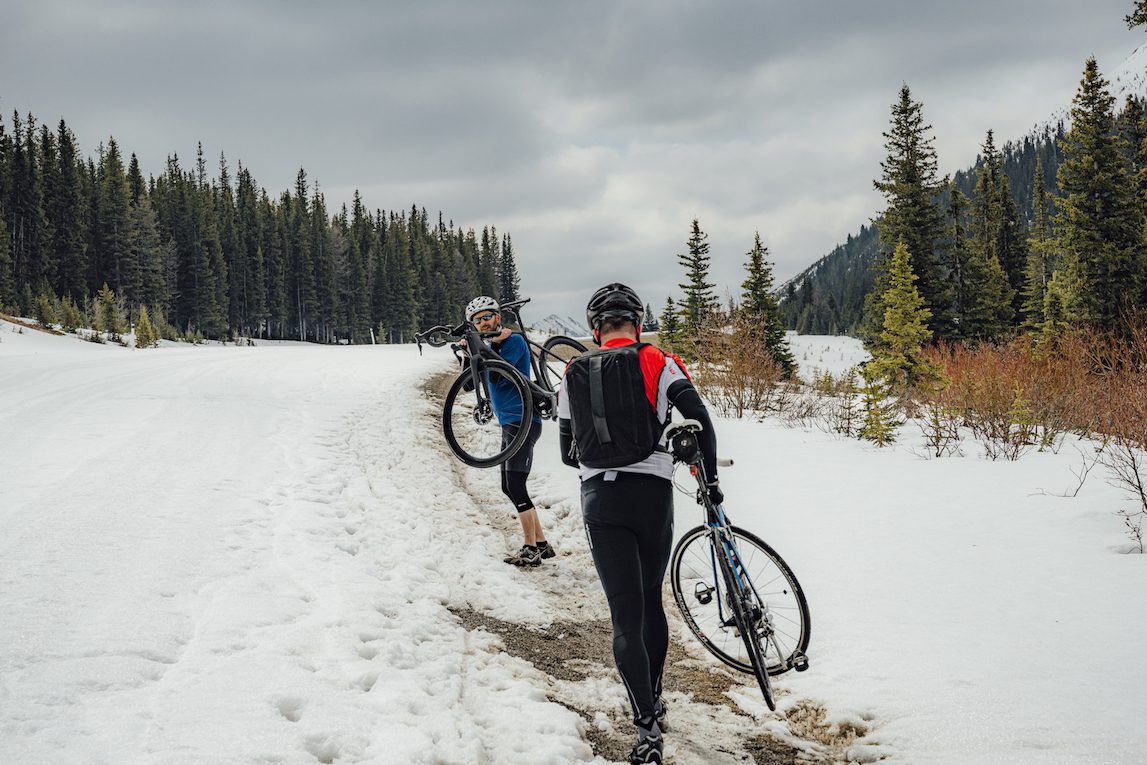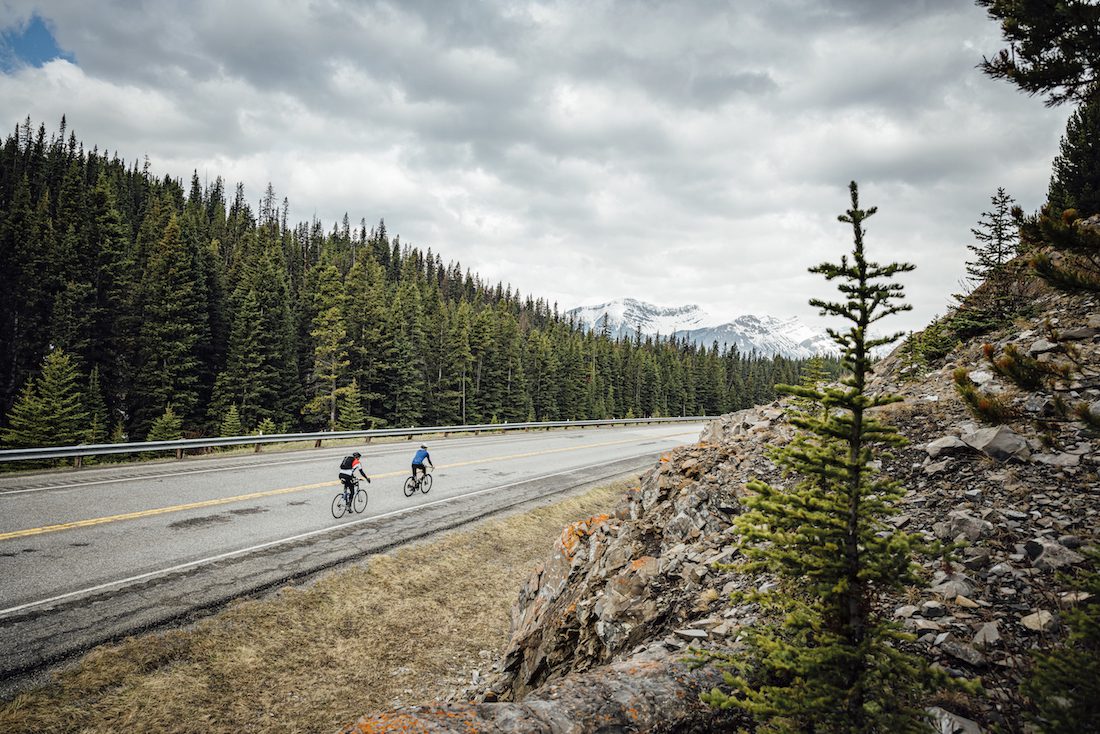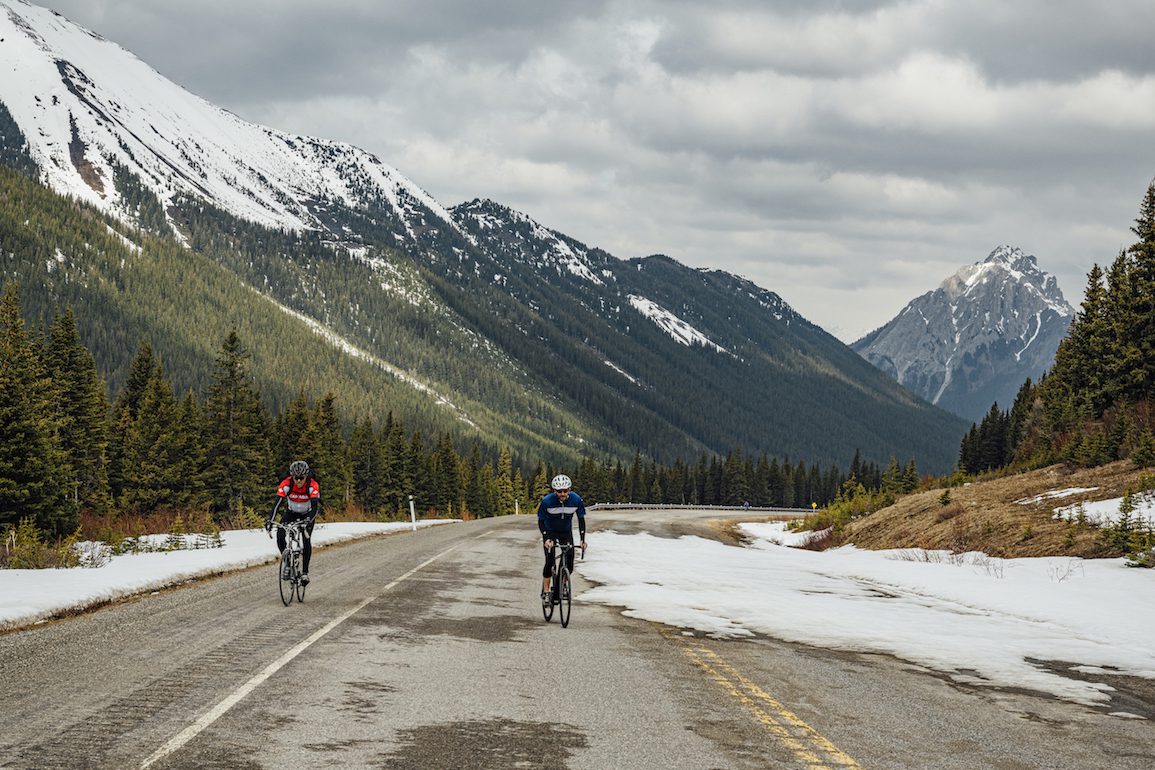Early season road riding: Taking on Highwood Pass, assisted
A spring ritual in southern Alberta with a new, electric, twist

by: Tom Babin
This article originally appeared in Canadian Cycling Magazine issue 10.4 Aug./Sept. 2019. Please respect current social distancing guidelines and refrain from riding with anyone you are not isolating with.
Fat finds the cracks in your fitness routine – a minor injury, work travel that keeps you sedentary, offseason, or even in-season procrastination. Then it skulks its way around your midsection. When an invitation for the first big ride of the season lands in your inbox, those heretofore unnoticed 15 lb are suddenly drawing attention to themselves like a Kardashian.
For me, the email that highlighted that sneaking lard was an invitation for a spring ritual here in southern Alberta: riding the Highwood Pass. The highest paved road in Canada carves its way through the Rockies of Kananaskis Country. Come winter, gates on both ends close the pass to vehicle traffic , and don’t lift until mid-June. That creates a tempestuous window of time for an achingly beautiful 130-km car-free dream ride for roadies, between the moment the snow melts and the gates open to motor-vehicle traffic. But the pass is a mercurial beast. Some years, plows need to open the summit in mid-June. Others, it’s free of snow right to the 2,200-m top. That may sound annoying in its unpredictability, but that’s what gives the ride a special mythology. Issuing a summit snow report to co-workers on Monday morning is one of the great humble-brags of the cycling season.
But the romance of the pass also means you’re branded a special kind of wuss if you beg off the ride. That short car-free window of time makes it a now-or-never decision that, if you decline, you’ll regret all season. This was the conundrum I faced. I knew I’d beat myself up all season if I missed that ride, but as an out-of-shape road-cycling dilettante, acceptance would be folly. If only someone would invent a way to get aging, out-of-shape paunchies up a mountain a little bit easier.
In late 2018, a type of bicycle was purchased in the Netherlands that marked a milestone: for the first time, the Dutch had brought more e-bikes in a year than traditional city bikes. It was a symbolic change: the most bicycle-friendly country on Earth had gone electric.
It wasn’t a surprise because e-bikes sales had been climbing for years, but it was a symbolic change. Here in North America, sales of e-bikes trailed far behind, but 2018 showed that unmistakable trend as well: e-bikes sales in the U.S. grew by 79 per cent. While that was still just a fraction of the total, that number had Trek CEO John Burke gushing about the near future in which 30 per cent of sales would be electric. “It is safe to say that e-bikes could represent a greater growth opportunity than mountain bikes did in the late ‘80s and early ‘90s or carbon road bikes in the early 2000s,” he wrote on Bicycle Retailer.
I’ve seen the creeping acceptance of e-bikes in the flesh. As recently as three years ago, they were a novelty. Now I see them every day on my bike commute. Out on the singletrack, pedal-assist mountain bikes power past thigh-powered saps regularly. And when bike-sharing company Lime dropped a few hundred pedal assists into Calgary last year, e-bikes were inescapable. Along with ubiquity came acceptance. The early stigma around e-bikes that labelled them as machines for cheaters also seemed to have faded. If e-bikes get more people riding, what could be wrong with that?
Resistance might remain for that bastion of bicycle masochism: road cyclists. The refuge of the sufferers. There had been whispers of electric road bikes for years, but they remained a rarity which, in the minds of many road cyclists, was a good thing. For a sport that’s built on romance of self-flagellation, sniffing at power assists has, in most corners, remained the default attitude.
But after a visit to my local bike shop early this past spring, I saw a crack in that thinking in the form of Cube Agree Hybrid, a gorgeous carbon-everything road bike with electronic shifters, a Knight Rider paint job and sexiness to burn. The only thing that marked this as a pedal-assist e-bike was a wide downtube that housed the battery. This, I thought, was the answer to my conundrum.
 I replied to the Highwood Pass invitation: I’m in.
I replied to the Highwood Pass invitation: I’m in.
You know when you complete a punishing fitness ride early in the season and your legs feel like cookie dough and why do you keep doing this to yourself because cycling is hard but then a few days go by and you forget the pain and go for another ride and you crush the first hill because you’re stronger and you feel the confidence returning and oh yeah this whole cycling thing is pretty great? That was my pre-ride with the Cube the day before the pass, only without the punishment before-hand. The bike crackled beneath me. It begged for hills. I felt like I was pedalling with someone else’s legs.
The day came and I arrived at the entrance to the Highwood. I tentatively gauged the fitness of my fellow riders. I’ve been on the indoor trainer all winter, said one, and I just spent a week riding in California. I gazed up at the road ascended into the Rockies and my stomach dropped.
But there I was on Monday morning at work, showing off photos on my phone and issuing my report to co-workers: there was snow at the summit.


